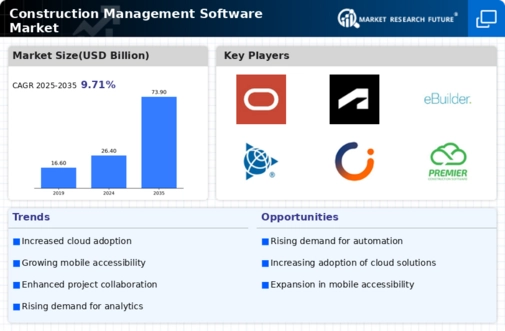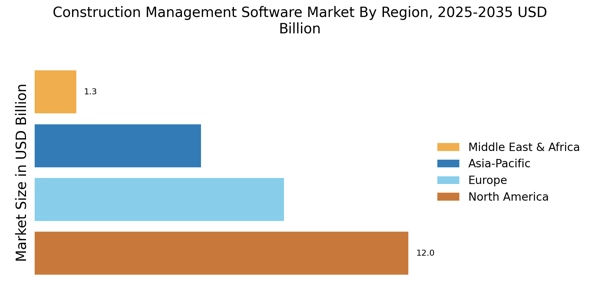Increased Demand for Efficiency
The Construction Management Software Market is experiencing a notable surge in demand for efficiency across construction projects. As stakeholders seek to optimize resource allocation and minimize waste, software solutions that streamline project management processes are becoming essential. According to recent data, the construction sector has seen a 15% increase in productivity when utilizing advanced management software. This trend indicates a shift towards technology-driven solutions that enhance collaboration and communication among teams. Consequently, construction firms are increasingly investing in software that offers real-time data analytics and project tracking capabilities, which are vital for meeting tight deadlines and budget constraints. The emphasis on efficiency is likely to continue driving growth in the Construction Management Software Market, as companies strive to remain competitive in a rapidly evolving landscape.
Growing Adoption of Mobile Solutions
The Construction Management Software Market is experiencing a growing adoption of mobile solutions, driven by the need for flexibility and accessibility in project management. As construction teams increasingly operate in dynamic environments, mobile applications that provide on-the-go access to project data are becoming essential. Recent statistics indicate that mobile-enabled construction management software can enhance team collaboration and communication by over 30%. This trend is particularly relevant as field workers require real-time updates and the ability to report issues directly from job sites. The shift towards mobile solutions is likely to continue, as construction firms recognize the benefits of improved efficiency and responsiveness. Consequently, software providers are focusing on developing robust mobile applications that cater to the specific needs of the construction workforce. This growing trend is expected to significantly impact the Construction Management Software Market, fostering innovation and enhancing overall project outcomes.
Regulatory Compliance and Safety Standards
The Construction Management Software Market is significantly influenced by the need for regulatory compliance and adherence to safety standards. As governments and regulatory bodies impose stricter guidelines on construction practices, software solutions that facilitate compliance tracking and reporting are gaining traction. For instance, the implementation of Building Information Modeling (BIM) has been shown to reduce compliance-related issues by up to 30%. This trend underscores the importance of integrating compliance features into construction management software, enabling firms to avoid costly penalties and enhance safety protocols. Furthermore, as the industry increasingly prioritizes worker safety, software that provides real-time monitoring and reporting capabilities is becoming indispensable. The growing focus on compliance and safety is expected to propel the demand for specialized construction management software, thereby shaping the future of the Construction Management Software Market.
Rise of Sustainable Construction Practices
The Construction Management Software Market is witnessing a paradigm shift towards sustainable construction practices. As environmental concerns become more pronounced, construction firms are increasingly adopting software solutions that support green building initiatives. Data suggests that projects utilizing sustainable practices can reduce energy consumption by up to 40%. This growing emphasis on sustainability is driving the demand for software that facilitates the planning and execution of eco-friendly projects. Features such as material tracking, waste management, and energy efficiency analysis are becoming standard in construction management software. As stakeholders recognize the long-term benefits of sustainable construction, including cost savings and enhanced reputation, the market for construction management software that aligns with these practices is likely to expand. This trend indicates a significant opportunity for software providers to innovate and cater to the evolving needs of the Construction Management Software Market.
Technological Advancements in Construction
The Construction Management Software Market is being propelled by rapid technological advancements that are transforming traditional construction methodologies. Innovations such as augmented reality (AR) and virtual reality (VR) are increasingly being integrated into construction management software, enhancing project visualization and planning. Recent studies indicate that the use of AR and VR can improve project outcomes by up to 25%, as these technologies allow for better stakeholder engagement and decision-making. Additionally, the integration of Internet of Things (IoT) devices into construction management software is enabling real-time monitoring of project progress and resource utilization. As these technologies continue to evolve, they are likely to redefine the capabilities of construction management software, making it an indispensable tool for modern construction firms. The ongoing technological evolution is expected to significantly influence the growth trajectory of the Construction Management Software Market.


















Leave a Comment